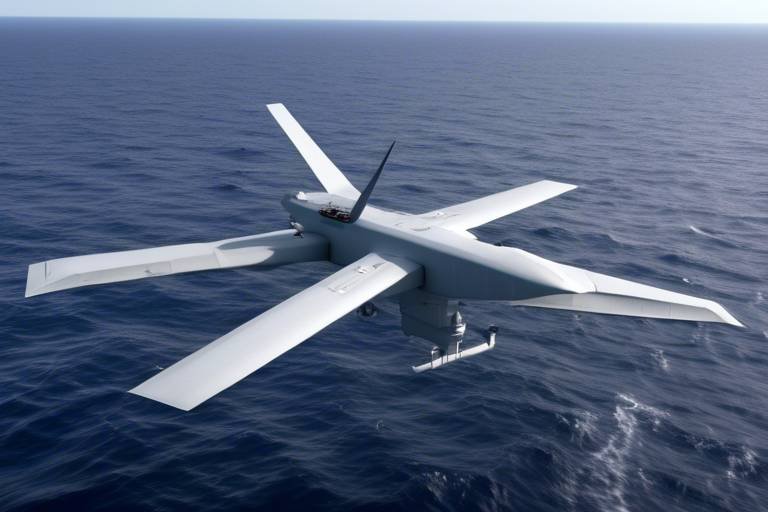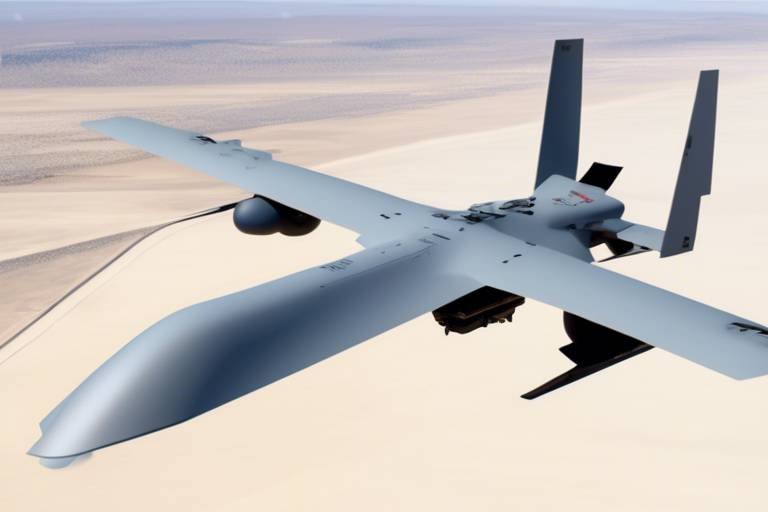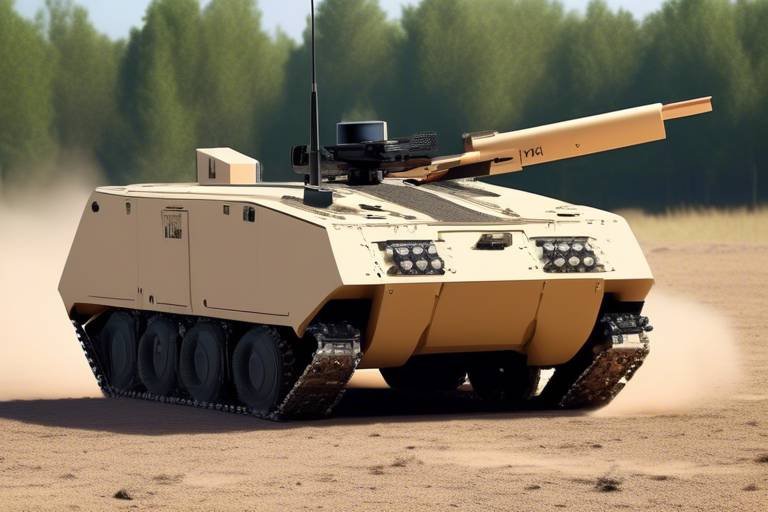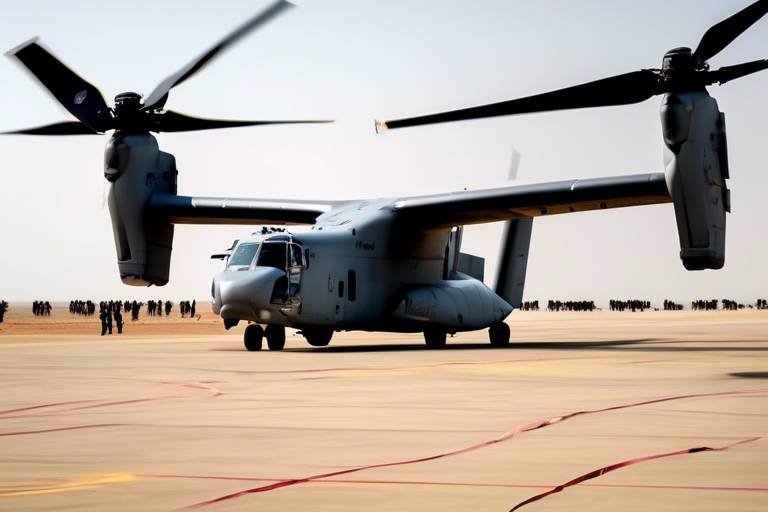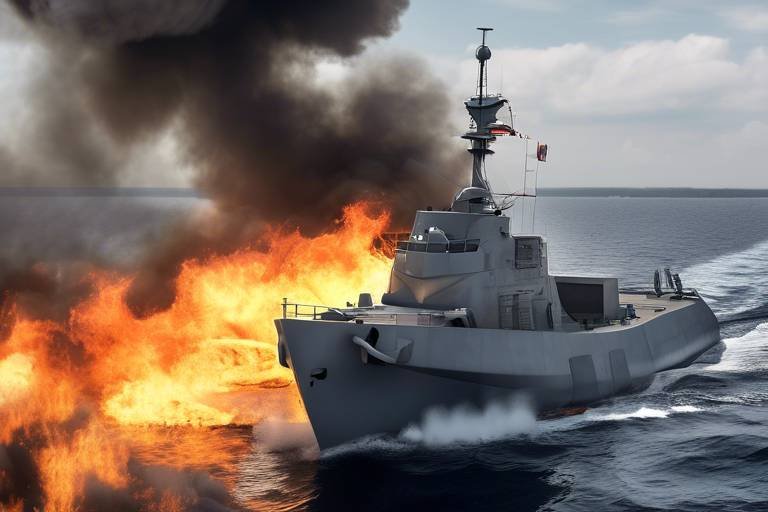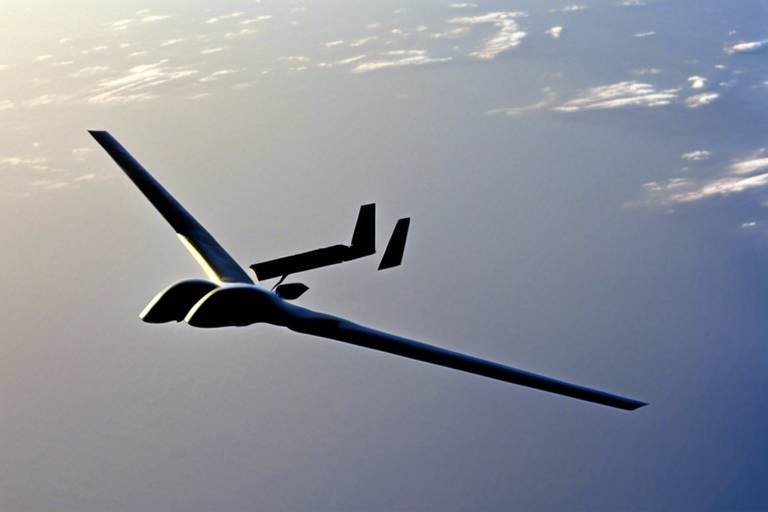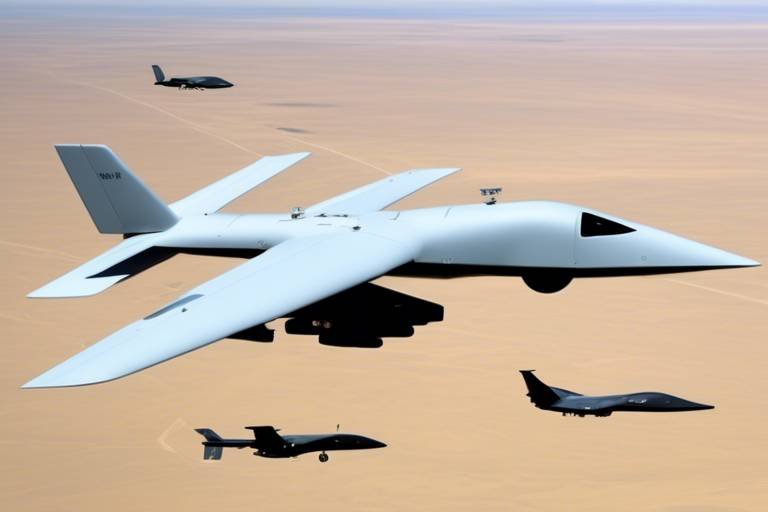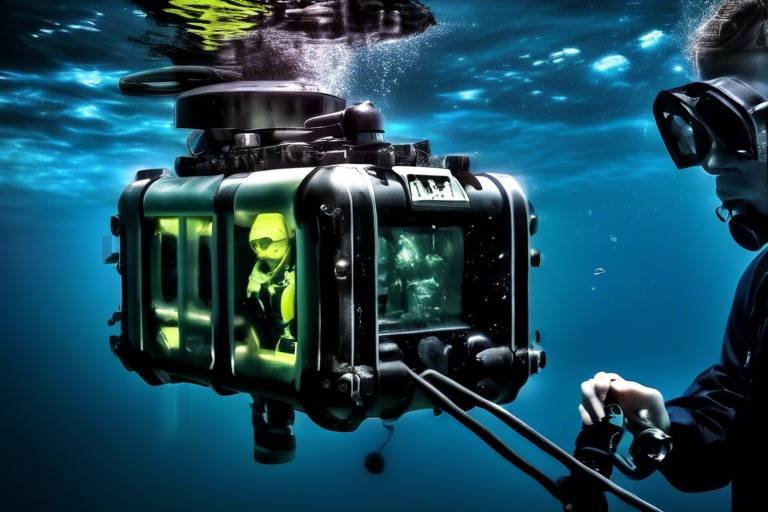The Role of the Coyote UAV in Maritime Surveillance
The Coyote UAV has emerged as a game-changer in the realm of maritime surveillance, offering a blend of advanced technology and operational versatility that is hard to match. Imagine having a watchful eye in the sky that can monitor vast stretches of ocean, track suspicious activities, and provide critical data to maritime authorities—all in real-time. This article delves into the significance of the Coyote UAV, exploring its capabilities, applications, and the technological advancements that bolster maritime security efforts.
The Coyote UAV represents a significant advancement in aerial technology, designed for versatile operations. Understanding its features and functionalities is crucial for appreciating its role in maritime surveillance. With a sleek design and cutting-edge technology, this UAV is not just another drone; it is a sophisticated tool that enhances situational awareness and operational efficiency. The Coyote UAV can be deployed in various conditions, making it adaptable to different missions, whether it's monitoring shipping lanes, conducting environmental assessments, or supporting search and rescue operations.
Equipped with a suite of advanced sensors and communication systems, the Coyote UAV enables real-time data collection and transmission. These features are essential for effective maritime surveillance and situational awareness. For instance, the UAV's high-resolution cameras and infrared sensors allow it to capture detailed imagery and detect heat signatures, which are invaluable in identifying vessels and monitoring their activities. Moreover, the UAV’s ability to transmit data in real-time means that decision-makers can react swiftly to any threats or anomalies.
The surveillance capabilities of the Coyote UAV allow for extensive monitoring of maritime environments. Its ability to cover large areas makes it an invaluable tool for naval operations and coastal security. Imagine being able to observe hundreds of square miles of ocean in a single flight, identifying potential threats before they escalate. This capability is particularly crucial in today’s world, where piracy, illegal fishing, and environmental crimes pose significant challenges to maritime security.
Real-time data collection is a critical aspect of the Coyote UAV’s operations. This capability enhances decision-making processes for maritime authorities and improves response times during incidents. For example, if the UAV detects a vessel engaging in suspicious behavior, it can immediately relay this information to the nearest coast guard unit, allowing for a rapid response. This immediacy can be the difference between successfully thwarting a crime and allowing it to escalate.
The Coyote UAV can seamlessly integrate with existing maritime surveillance systems. This interoperability enhances overall operational efficiency and strengthens situational awareness for maritime security agencies. By sharing data with other platforms, such as satellite systems and ground-based radar, the Coyote UAV contributes to a comprehensive picture of maritime activities. This synergy not only improves the effectiveness of individual missions but also fosters collaboration between different agencies tasked with maintaining maritime security.
Coyote UAVs are deployed in various maritime security applications, including:
- Anti-piracy operations: Monitoring high-risk areas to deter and respond to piracy incidents.
- Environmental monitoring: Tracking pollution and illegal dumping, ensuring compliance with environmental regulations.
- Search and rescue missions: Assisting in locating missing vessels and individuals at sea.
This versatility underscores the Coyote UAV's importance in safeguarding maritime interests and ensuring the safety of both vessels and the marine environment.
Despite its capabilities, the Coyote UAV faces challenges in maritime surveillance, including technological limitations and environmental factors. Addressing these challenges is essential for maximizing its effectiveness in various scenarios. For instance, while the UAV is designed to operate in diverse conditions, harsh maritime environments can still impact its performance. Factors such as high winds, saltwater corrosion, and limited visibility can pose significant hurdles.
Harsh maritime conditions can impact the performance of the Coyote UAV. Understanding these environmental limitations helps in strategizing optimal deployment and ensuring reliable operations. For example, during stormy weather, the UAV may need to adjust its flight patterns or even postpone missions to maintain operational integrity. This adaptability is crucial for ensuring that surveillance efforts are not compromised.
Technological challenges, such as data transmission issues and sensor limitations, can hinder the effectiveness of the Coyote UAV. Continuous advancements and innovations are necessary to overcome these obstacles and enhance operational capabilities. For instance, improving the range and reliability of communication systems will enable the UAV to operate effectively over longer distances, ensuring that it can maintain contact with command centers even in remote areas.
Q: What makes the Coyote UAV different from other drones?
A: The Coyote UAV is specifically designed for maritime surveillance, equipped with advanced sensors and real-time data transmission capabilities that enhance its effectiveness in monitoring maritime environments.
Q: How does the Coyote UAV contribute to maritime security?
A: By providing real-time surveillance, detecting suspicious activities, and assisting in search and rescue operations, the Coyote UAV plays a crucial role in enhancing maritime security and situational awareness.
Q: What are the limitations of the Coyote UAV?
A: Environmental factors such as harsh weather conditions and technological challenges like data transmission issues can impact the UAV's performance and effectiveness in surveillance operations.

Introduction to Coyote UAV Technology
The Coyote UAV represents a significant leap forward in aerial technology, tailored specifically for versatile operations in various environments. Imagine a bird that can soar high above the waves, equipped with cutting-edge technology that not only watches over vast expanses of ocean but also communicates vital information back to its operators in real-time. This is the essence of the Coyote UAV. It combines agility, advanced sensors, and robust communication systems, making it a game-changer in the realm of maritime surveillance.
Understanding the features and functionalities of the Coyote UAV is crucial for appreciating its role in maritime security. Designed to operate in challenging conditions, this UAV can navigate through rough weather and varying terrains, ensuring that it remains a reliable asset for naval operations. With its high endurance and low operational costs, the Coyote UAV can be deployed for extended missions, which is essential for continuous monitoring of maritime activities.
One of the most fascinating aspects of the Coyote UAV is its modular design. This allows for easy upgrades and modifications, adapting to the ever-evolving technological landscape. Whether it's enhancing its sensor suite or improving its communication capabilities, the Coyote UAV can be tailored to meet specific mission requirements. This adaptability not only boosts its operational effectiveness but also ensures that it remains relevant in a rapidly changing world.
Additionally, the Coyote UAV's ability to gather and transmit data in real-time is a game-changer for maritime authorities. By providing immediate access to critical information, it enhances decision-making processes and allows for quicker responses to incidents. Imagine having eyes in the sky that can relay information instantly, helping to prevent illegal activities such as piracy or smuggling. This capability is vital for maintaining maritime security and protecting national interests.
In summary, the Coyote UAV is not just another drone; it is a sophisticated tool that enhances maritime surveillance efforts. Its advanced technology and operational flexibility make it an invaluable asset for safeguarding our oceans and ensuring the safety of maritime operations.
- What is the range of the Coyote UAV? The Coyote UAV can cover extensive distances, typically ranging up to 100 miles, depending on the mission profile and environmental conditions.
- How does the Coyote UAV communicate data? It utilizes advanced communication systems to transmit data in real-time back to command centers, ensuring timely decision-making.
- Can the Coyote UAV operate in adverse weather conditions? Yes, the Coyote UAV is designed to withstand harsh maritime environments, making it suitable for operations in various weather conditions.
- What types of sensors are used in the Coyote UAV? The UAV can be equipped with a variety of sensors, including optical cameras, infrared sensors, and radar systems, based on the mission requirements.

Key Features of the Coyote UAV
The Coyote UAV stands out in the realm of aerial technology, especially when it comes to maritime surveillance. This remarkable drone is not just a flying machine; it's a sophisticated tool equipped with cutting-edge technology that enhances its operational capabilities. One of the most impressive aspects of the Coyote UAV is its advanced sensor suite. These sensors are designed to gather a plethora of data, from visual imagery to thermal readings, enabling the UAV to operate effectively in various environmental conditions. Imagine having a bird's eye view of vast ocean expanses, where every wave and ripple can be monitored in real-time—this is what the Coyote UAV offers.
Another key feature is its robust communication systems. The Coyote UAV is equipped with high-bandwidth data links that allow for seamless transmission of information back to command centers. This capability is crucial for real-time decision-making, especially in scenarios where every second counts. For instance, during a search and rescue operation, the ability to relay information instantly can mean the difference between life and death. The UAV's communication systems ensure that operators are always in the loop, receiving live updates and data feeds from the field.
Moreover, the Coyote UAV is designed for long endurance. Its fuel-efficient engines allow it to stay airborne for extended periods, covering large areas without the need for frequent refueling. This endurance is particularly beneficial for maritime surveillance, where the vastness of the ocean can make traditional monitoring methods inefficient. The UAV can patrol extensive stretches of water, detecting anomalies and potential threats long before they become critical issues.
In addition to its surveillance capabilities, the Coyote UAV boasts a modular design. This feature allows for easy upgrades and adaptations, making it a versatile platform that can be customized for different missions. Whether it's outfitting the UAV with new sensors for environmental monitoring or equipping it for anti-piracy operations, the modularity of the Coyote ensures that it remains relevant in a rapidly evolving technological landscape.
Lastly, the Coyote UAV excels in interoperability. It can integrate seamlessly with existing maritime surveillance systems, enhancing overall operational efficiency. This means that the UAV can work in conjunction with other surveillance assets, such as satellites and manned aircraft, creating a comprehensive picture of maritime activity. The synergy between these systems not only improves situational awareness but also strengthens the capabilities of maritime security agencies.
| Feature | Description |
|---|---|
| Advanced Sensors | Collects various types of data for comprehensive monitoring. |
| Communication Systems | Ensures real-time data transmission to command centers. |
| Long Endurance | Can operate for extended periods, covering large maritime areas. |
| Modular Design | Allows for easy upgrades and mission-specific adaptations. |
| Interoperability | Integrates with existing surveillance systems for enhanced efficiency. |
- What is the primary purpose of the Coyote UAV?
The primary purpose of the Coyote UAV is to enhance maritime surveillance capabilities, providing real-time data and monitoring vast ocean areas. - How does the Coyote UAV communicate with command centers?
The Coyote UAV uses high-bandwidth data links that allow for seamless and instantaneous communication with command centers. - Can the Coyote UAV operate in harsh weather conditions?
Yes, the Coyote UAV is designed to withstand various environmental conditions, although extreme weather can still pose challenges. - Is the Coyote UAV customizable for different missions?
Absolutely! Its modular design allows for easy customization and upgrades based on mission requirements.

Surveillance Capabilities
The Coyote UAV is a game changer when it comes to maritime surveillance. Imagine having an eye in the sky that can monitor vast stretches of ocean with precision and efficiency. This remarkable UAV is designed to cover large areas quickly, making it an invaluable asset for naval operations and coastal security. Its ability to operate in various weather conditions and terrains allows it to gather crucial intelligence that would otherwise be difficult to obtain.
Equipped with state-of-the-art sensors, the Coyote UAV can detect and track multiple targets simultaneously. This capability is particularly important for missions that require the monitoring of suspicious vessels or illegal activities at sea. The UAV can provide real-time video feeds and high-resolution images, which not only enhance situational awareness but also aid in making informed decisions swiftly. For instance, during anti-piracy operations, the Coyote UAV can identify potential threats before they escalate, allowing naval forces to respond proactively.
One of the standout features of the Coyote UAV is its extended flight endurance. With the ability to stay airborne for several hours, it can conduct long-range surveillance missions without needing to return to base frequently. This endurance is critical for operations in remote maritime areas where traditional surveillance methods may fall short. Moreover, its stealth technology minimizes detection by adversaries, allowing for covert operations that can gather intelligence without alerting potential threats.
Furthermore, the Coyote UAV's surveillance capabilities are enhanced through its advanced communication systems. It can transmit data in real-time to command centers, ensuring that decision-makers have access to the latest information. This capability is vital during search and rescue missions, where timely information can mean the difference between life and death. By integrating with other maritime systems, the Coyote UAV can create a comprehensive surveillance network that enhances overall maritime security.
In summary, the Coyote UAV's surveillance capabilities are a blend of advanced technology and operational versatility. Its ability to monitor vast maritime environments, coupled with real-time data collection and communication, positions it as a crucial tool for enhancing maritime security. Whether it's tracking illegal fishing activities, monitoring environmental changes, or aiding in search and rescue operations, the Coyote UAV is redefining what is possible in maritime surveillance.
- What is the range of the Coyote UAV?
The Coyote UAV can cover significant distances, making it suitable for extensive maritime operations. - How does the Coyote UAV handle adverse weather conditions?
It is designed to operate in various weather conditions, although extreme conditions may still pose challenges. - Can the Coyote UAV be used for commercial purposes?
Yes, it can be adapted for various applications, including environmental monitoring and resource management.

Real-time Data Collection
The Coyote UAV excels in real-time data collection, a feature that is absolutely vital for effective maritime surveillance. Imagine being able to monitor vast stretches of ocean in real-time, gathering crucial information that can aid in decision-making and enhance security measures. This capability transforms the way maritime authorities operate, allowing them to respond to incidents almost instantaneously. The UAV is equipped with advanced sensors that capture high-resolution imagery and collect data on various environmental parameters, including temperature, humidity, and even wave patterns.
One of the standout features of the Coyote UAV is its ability to transmit collected data back to command centers in real-time. This means that as the UAV is patrolling the waters, the information it gathers is being analyzed and acted upon without delay. This is akin to having a pair of eyes in the sky that can see and relay information faster than any human ever could. The UAV’s communication systems ensure that data is not only collected but also shared seamlessly across different platforms, enhancing situational awareness for all stakeholders involved.
Moreover, the integration of machine learning algorithms allows the Coyote UAV to filter and prioritize data, focusing on what matters most. For instance, if the UAV detects an anomaly in a shipping route, it can alert operators immediately, enabling them to assess the situation and take necessary actions. This level of responsiveness is crucial, especially in scenarios like search and rescue missions or anti-piracy operations, where every second counts.
In addition to its real-time capabilities, the Coyote UAV also supports multi-sensor fusion. This means it can combine data from various sensors to provide a more comprehensive picture of the maritime environment. For example, it can integrate visual data from cameras with radar readings, creating a detailed situational overview that enhances decision-making processes. This feature is particularly useful for identifying potential threats or monitoring environmental changes.
| Feature | Description |
|---|---|
| Real-time Data Transmission | Immediate relay of information to command centers for quick decision-making. |
| High-resolution Imaging | Capture detailed images for accurate monitoring and assessment. |
| Multi-sensor Fusion | Combines data from various sensors for a comprehensive situational overview. |
| Machine Learning Algorithms | Filters and prioritizes data to focus on critical information. |
In conclusion, the capabilities of the Coyote UAV not only enhance maritime surveillance but also revolutionize the way maritime authorities operate. With the ability to gather, analyze, and transmit data almost instantaneously, the Coyote UAV stands as a formidable ally in ensuring maritime security and safety.
- What is the primary function of the Coyote UAV?
The Coyote UAV is primarily designed for maritime surveillance, enabling real-time monitoring and data collection to enhance security and operational efficiency. - How does the Coyote UAV transmit data?
The UAV utilizes advanced communication systems to relay real-time data back to command centers, ensuring quick decision-making and response. - Can the Coyote UAV operate in harsh weather conditions?
While the Coyote UAV is built for versatility, extreme environmental factors can affect its performance, necessitating careful planning for deployment. - What types of sensors are equipped on the Coyote UAV?
The UAV is equipped with various sensors, including high-resolution cameras and environmental sensors, to gather comprehensive data during its operations.

Integration with Other Systems
The Coyote UAV stands out not just for its advanced features but also for its remarkable ability to integrate with other systems seamlessly. This integration is crucial, as it allows the UAV to function as a part of a larger network of maritime surveillance tools. Imagine a symphony where each instrument plays its part in harmony; that’s how the Coyote UAV collaborates with other technologies to enhance maritime security.
One of the key aspects of this integration is its interoperability with existing maritime surveillance systems. The Coyote UAV can connect with radar systems, satellite communications, and even other UAVs, creating a comprehensive surveillance network. This interconnectedness ensures that data flows smoothly between systems, providing real-time situational awareness to maritime authorities. For instance, when the Coyote UAV detects an anomaly in the water, it can immediately relay that information to a command center, which can then coordinate a response with other assets in the area.
Furthermore, the Coyote UAV is equipped with advanced communication protocols that enhance its ability to share data. These protocols ensure that the UAV can operate in various environments, whether it's near-shore or far out at sea. By utilizing secure communication channels, the UAV can transmit high-definition video feeds and sensor data without interruption, allowing for timely decision-making.
Another significant advantage of the Coyote UAV's integration capabilities is its adaptability to emerging technologies. As maritime threats evolve, so must the tools designed to combat them. The Coyote UAV can be upgraded with new sensors or software that enhance its functionality. For example, incorporating artificial intelligence (AI) algorithms can improve its target detection and tracking capabilities, making it an even more valuable asset in maritime operations.
In summary, the integration of the Coyote UAV with other systems is not just a technical feature; it is a game-changer in maritime surveillance. By working in concert with existing technologies, the Coyote UAV enhances the overall effectiveness of maritime security operations, ensuring that authorities can respond swiftly and effectively to any challenges that arise.
- What is the Coyote UAV used for? The Coyote UAV is primarily used for maritime surveillance, including anti-piracy operations, environmental monitoring, and search and rescue missions.
- How does the Coyote UAV integrate with other systems? It integrates seamlessly with existing maritime surveillance systems, allowing for real-time data sharing and enhanced situational awareness.
- What are the key features of the Coyote UAV? Key features include advanced sensors, real-time data collection capabilities, and robust communication systems.
- What challenges does the Coyote UAV face in maritime surveillance? Challenges include environmental limitations, technological challenges, and the need for continuous advancements to improve its operational capabilities.

Applications in Maritime Security
The Coyote UAV has carved out a niche for itself in the realm of maritime security, proving to be an indispensable asset across various applications. From combating piracy to monitoring environmental changes, the UAV's versatility is nothing short of remarkable. Imagine a bird's-eye view of the vast ocean, where every movement is tracked, and every anomaly is investigated. That's the power of the Coyote UAV in action!
One of the most critical applications of the Coyote UAV is in anti-piracy operations. The UAV's ability to cover large distances quickly allows naval forces to patrol vast areas of ocean, deterring potential piracy activities. With its advanced surveillance capabilities, the Coyote can identify suspicious vessels, relay real-time data to command centers, and assist in coordinating responses. This proactive approach is crucial in regions where piracy is rampant, ensuring that maritime routes remain safe for commercial shipping.
Another significant application is in environmental monitoring. The Coyote UAV is equipped with sensors that can detect changes in water quality, track oil spills, and monitor marine life. This data is vital for environmental agencies and organizations working to protect our oceans. By providing real-time information, the UAV helps in making informed decisions regarding conservation efforts and disaster response. Think of it as a lifeguard for the ocean, always on the lookout for signs of distress.
Additionally, the Coyote UAV plays a crucial role in search and rescue missions. In emergencies, every second counts, and the UAV's ability to quickly survey vast areas can mean the difference between life and death. By deploying the Coyote, rescue teams can locate missing vessels or individuals much faster than traditional methods would allow. Its real-time data transmission capabilities ensure that rescuers have up-to-date information on the situation, enabling them to respond effectively.
Furthermore, the integration of the Coyote UAV with other maritime systems enhances its effectiveness. For instance, when combined with satellite data and other surveillance technologies, the UAV can provide a comprehensive picture of maritime activities. This synergy not only boosts situational awareness but also allows for coordinated responses to incidents, making maritime security efforts more efficient.
In summary, the applications of the Coyote UAV in maritime security are vast and varied. Whether it's deterring piracy, monitoring environmental health, or aiding in search and rescue operations, the UAV stands as a testament to how technology can enhance our ability to safeguard the seas. As we continue to innovate and integrate such technologies, the future of maritime security looks promising.
- What is the Coyote UAV? The Coyote UAV is an advanced unmanned aerial vehicle designed for versatile operations, particularly in maritime surveillance.
- How does the Coyote UAV assist in anti-piracy operations? It provides real-time surveillance and data collection, enabling naval forces to monitor and respond to suspicious activities effectively.
- Can the Coyote UAV monitor environmental changes? Yes, it is equipped with sensors that can detect changes in water quality and track environmental incidents like oil spills.
- What role does the Coyote UAV play in search and rescue missions? Its rapid surveying capabilities allow rescue teams to locate missing individuals or vessels quickly, improving response times significantly.

Challenges in Maritime Surveillance
Despite the impressive capabilities of the Coyote UAV, it faces a myriad of challenges in the realm of maritime surveillance. These challenges can significantly impact its operational effectiveness and overall mission success. One of the primary hurdles is the environmental limitations posed by the harsh maritime conditions. The ocean is not always a friendly environment; it can be unpredictable and tumultuous. High winds, heavy rainfall, and rough seas can hinder the UAV's ability to maintain stable flight and collect accurate data. For instance, imagine trying to take a clear photograph during a storm—it's nearly impossible! Similarly, the Coyote UAV’s sensors may struggle to function optimally under such adverse conditions, which can lead to gaps in surveillance coverage.
Additionally, technological challenges also plague the Coyote UAV. Data transmission issues can arise, especially when the UAV is operating far from shore or in areas with limited communication infrastructure. This can lead to delays in real-time data sharing, which is crucial for timely decision-making. Furthermore, the UAV's sensors, while advanced, are not infallible. They can be affected by factors such as electromagnetic interference or physical obstructions, which may limit their effectiveness in detecting and identifying maritime threats.
To truly grasp the impact of these challenges, consider the following table that outlines the key obstacles faced by the Coyote UAV in maritime surveillance:
| Challenge | Description | Impact on Operations |
|---|---|---|
| Environmental Limitations | Harsh weather conditions affecting flight stability and sensor performance. | Reduced surveillance coverage and data accuracy. |
| Data Transmission Issues | Challenges in sending real-time data back to command centers. | Delays in decision-making and response times. |
| Sensor Limitations | Potential interference or obstructions impacting sensor functionality. | Inability to detect or identify threats accurately. |
Addressing these challenges is essential for maximizing the effectiveness of the Coyote UAV in various maritime scenarios. Continuous advancements in technology and operational strategies are necessary to mitigate these limitations. For instance, enhancing the UAV's design to withstand extreme weather or improving data encryption methods to ensure reliable transmission can significantly bolster its capabilities. Furthermore, integrating the Coyote UAV with other surveillance systems can create a more robust network, allowing for better data sharing and situational awareness.
- What is the primary purpose of the Coyote UAV?
The Coyote UAV is primarily used for maritime surveillance, including monitoring for piracy, environmental changes, and search and rescue operations. - How does the Coyote UAV collect data?
The UAV is equipped with advanced sensors that allow it to gather real-time data, which is then transmitted back to command centers for analysis. - What are the environmental factors that affect the Coyote UAV?
Harsh weather conditions such as high winds, rain, and rough seas can impact the UAV's performance and data collection capabilities. - What technological advancements are needed for the Coyote UAV?
Improvements in data transmission technology, sensor reliability, and environmental resilience are vital for enhancing the UAV's operational effectiveness.

Environmental Limitations
The Coyote UAV, while a marvel of modern technology, is not without its . These limitations can significantly impact its operational effectiveness in maritime surveillance. Imagine trying to navigate a ship through a storm; similarly, the Coyote UAV faces challenges when the weather turns harsh. Factors such as high winds, rain, and salt spray can affect its performance and reliability. For instance, strong winds can lead to instability during flight, causing difficulties in maintaining a steady position for surveillance tasks.
Moreover, the UAV's sensors, designed to collect critical data, may struggle under adverse conditions. Heavy rainfall can obscure visibility, while salt accumulation can impair sensor functionality over time. This is akin to trying to see through a fogged-up window; the clarity of the data collected can be compromised, leading to potential gaps in situational awareness. To illustrate the impact of environmental conditions on the Coyote UAV, consider the following table:
| Environmental Factor | Impact on Coyote UAV |
|---|---|
| High Winds | Instability in flight, difficulty in maintaining position |
| Heavy Rain | Reduced visibility, impaired sensor functionality |
| Salt Spray | Corrosion of sensors, decreased operational lifespan |
To maximize the Coyote UAV's effectiveness in challenging environments, it is essential for operators to be aware of these limitations. This awareness allows for better strategic planning and deployment. For example, during periods of inclement weather, operators might opt to delay missions or adjust flight paths to avoid the worst conditions. Furthermore, ongoing maintenance is crucial; regular checks and cleaning can mitigate some of the negative effects of environmental exposure.
In conclusion, while the Coyote UAV is equipped with advanced technology, its operational success in maritime surveillance is closely tied to environmental conditions. Understanding and addressing these limitations is vital for ensuring that this UAV can continue to serve as a reliable asset for maritime security.
- What is the Coyote UAV? The Coyote UAV is an advanced unmanned aerial vehicle designed for versatile operations, particularly in maritime surveillance.
- How does weather affect the Coyote UAV? Harsh weather conditions such as high winds and heavy rain can impact its stability, visibility, and sensor functionality.
- What are the primary applications of the Coyote UAV? The Coyote UAV is used in anti-piracy operations, environmental monitoring, and search and rescue missions.
- Can the Coyote UAV operate in all weather conditions? No, the Coyote UAV has limitations in extreme weather conditions, which can hinder its performance.

Technological Challenges
The Coyote UAV, while a marvel of modern technology, does not come without its share of . One of the primary hurdles is the issue of data transmission. In maritime environments, where vast expanses of water can hinder communication signals, maintaining a stable connection becomes critical. Imagine trying to have a conversation on a phone while you're surrounded by static; that’s akin to the challenges faced by the Coyote when relaying important information back to its operators. This can lead to delays in decision-making, which is particularly detrimental in situations that require immediate action.
Moreover, the sensors equipped on the Coyote UAV, while advanced, are not infallible. They may struggle to perform optimally under certain conditions, such as heavy rain or fog. These environmental factors can significantly impact the UAV's ability to gather accurate data, which is essential for effective surveillance. To illustrate this, consider a camera trying to take a clear picture during a snowstorm; the results will likely be less than satisfactory. This limitation necessitates ongoing research and development to enhance sensor technologies, ensuring they can withstand the unpredictable nature of maritime weather.
Another challenge lies in the integration of new technologies with existing systems. The maritime domain is populated with various surveillance technologies, and the Coyote must be able to work alongside these systems seamlessly. This interoperability is crucial for maximizing the UAV's effectiveness and ensuring that maritime authorities can leverage all available resources for comprehensive situational awareness. If the Coyote UAV cannot communicate or share data with other surveillance systems, it risks becoming a standalone tool rather than a vital component of a larger security framework.
In conclusion, while the Coyote UAV is a powerful asset in maritime surveillance, addressing its technological challenges is essential for optimizing its operational capabilities. Continuous innovation and adaptation are necessary to overcome issues related to data transmission, sensor performance, and system integration. By focusing on these areas, we can enhance the Coyote's effectiveness, ensuring it remains a key player in safeguarding our maritime interests.
- What are the main functions of the Coyote UAV in maritime surveillance?
The Coyote UAV is primarily used for real-time monitoring, data collection, and integration with other maritime surveillance systems to enhance situational awareness. - How does the Coyote UAV handle adverse weather conditions?
While it is equipped with advanced sensors, the UAV's performance can be affected by harsh weather such as heavy rain or fog, which can impair data collection. - Can the Coyote UAV operate autonomously?
Yes, the Coyote UAV can be programmed for autonomous operations, but it is often monitored in real-time by operators to ensure optimal performance and safety. - What advancements are being made to improve the Coyote UAV?
Ongoing research focuses on enhancing data transmission capabilities, improving sensor technology, and ensuring better integration with existing maritime systems.
Frequently Asked Questions
- What is the Coyote UAV?
The Coyote UAV is an advanced unmanned aerial vehicle designed for versatile operations, particularly in maritime surveillance. It is equipped with cutting-edge sensors and communication systems that enable it to collect and transmit real-time data, making it an essential tool for monitoring maritime environments.
- How does the Coyote UAV enhance maritime surveillance?
The Coyote UAV enhances maritime surveillance through its extensive surveillance capabilities. It can cover large areas efficiently, providing crucial situational awareness for naval operations and coastal security. Its ability to integrate with existing maritime systems further boosts operational efficiency.
- What are the key features of the Coyote UAV?
Key features of the Coyote UAV include advanced sensors for real-time data collection, robust communication systems for data transmission, and the ability to operate in various environmental conditions. These features allow for effective monitoring and quick response during maritime incidents.
- In what applications is the Coyote UAV used?
The Coyote UAV is utilized in several maritime security applications, including anti-piracy operations, environmental monitoring, and search and rescue missions. Its versatility makes it a vital asset in safeguarding maritime interests and ensuring safety at sea.
- What challenges does the Coyote UAV face in maritime surveillance?
Despite its capabilities, the Coyote UAV faces challenges such as environmental limitations, including harsh weather conditions that can affect its performance. Additionally, technological challenges like data transmission issues and sensor limitations can hinder its effectiveness in certain scenarios.
- How does the Coyote UAV collect real-time data?
The Coyote UAV collects real-time data through its advanced sensors that monitor various maritime parameters. This data is then transmitted to command centers, allowing maritime authorities to make informed decisions quickly and improve response times during incidents.
- Can the Coyote UAV operate in adverse weather conditions?
While the Coyote UAV is designed to operate in various conditions, adverse weather can still pose challenges. Understanding these limitations is crucial for strategizing optimal deployment and ensuring reliable operations during missions.





